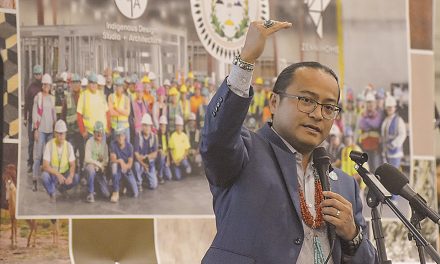
50 years ago: No news was not necessarily good news
Fifty years ago, fewer than 10 percent of the tribal members who lived on the reservation had 9-to-5 jobs and got a regular salary.
As a result, the two top industries on the reservation were ranching and the production of arts and crafts, with most people thinking that more Navajos earned their income from ranching or herding sheep than by producing arts and crafts, although there were many who did both.
Navajo Tribal President Raymond Nakai in March of 1967 said things were happening off the reservation that would prove to be a boon to those on the reservation who made rugs and jewelry.
The reason behind this was a series of statements that Robert Bennett, the Commissioner of Indian Affairs had been making to members of Congress since the beginning of 1967.
“It’s time,” said Bennett, “for a complete reversal of the way the things have been for more than a century. Instead of American Indians buying a lot of their stuff from European nations,” he said, “now it’s time the Indians turn to trade with the European nations.”
Tribal officials had been reporting for years the popularity of reservation sites for foreign visitors, especially from Germany, who came by the thousands each summer to visit the reservation and buy arts and crafts.
In fact, before World War II started, the Germans and Japanese probably accounted for more tourists in the summer than people from the neighboring states, according to studies which said that American tourism in the Southwest didn’t pick up until after the war.
Bennett said three Indians, including Miss Indian America, as well as the curator of the Navajo Tribal Museum, were planning to leave at the end of the month for Germany.
Martin Link, the museum’s curator, was picked to head the group. Also going from the Navajo Reservation was Lou Dahozy, a Navajo weaver from Fort Defiance and Charles Chee Long, a Navajo silversmith from Navajo Mountain and Link’s assistant at the museum.
The group would promote Indian arts and crafts in Germany and other countries and would demonstrate Indian dancing and the production of crafts from rugs and silversmithing to beadwork.
Bennett predicted that the stories in the foreign papers would be generated from this visit and would create a huge demand for Indian arts and crafts.
“We have never done this before,” said Bennett, “but everything indicates that this will be a huge success.”
As part of the project, Indian traders in and around Gallup and the reservation would provide $15,000 worth of Indian arts and crafts to be exhibited during the tour.
One of the big problems faced by the Navajo Times 50 years ago and one that exists to a great extent today was the lack of any news about crimes that were committed on the reservation.
It’s not that there wasn’t crime on the reservation; of course there was, and reservation residents complained just as much about the lack of law enforcement in their areas as they do today.
The big difference was back in 1967 the BIA had a lot more supervision over the handling crime on the reservation. It would be another decade before the BIA would turn over complete control of the police department to the tribe.
But that doesn’t mean that tribal members were completely shut out from knowing about crime in their communities.
Throughout the 1960s, the chapter government was probably at its peak with most chapter meetings packed with attendees, not because they cared about what the chapter was doing but chapter meetings provided their members with the news happening in their area more than any other source, including newspapers and radio.
If there were an increase in break-ins and other crimes, many chapters would pass a resolution and then take the step to put pressure on the local police to do something about it.
None of this made its way to the Times.
There didn’t seem to be any pressure put on the Times to start covering crime news and even if there was, the Times didn’t have anywhere near the manpower to do it.
The only thing it did do was publish letters from reservation residents complaining about the lack of police coverage and blaming tribal officials for not putting more resources to solving the problem.
Chet Macrorie, the editor of the Times throughout much of the 60s, said years later that he and others in the paper would hear of someone being killed on the reservation and then hear a few days later of a second murder, this one by a family member seeking revenge against the person they believed did the first killing.
Whether this was true or not, no one knew, but it probably gave people who did kill someone something to worry about.
To read the full article, pick up your copy of the Navajo Times at your nearest newsstand Thursday mornings!
Are you a digital subscriber? Read the most recent three weeks of stories by logging in to your online account.








 Highway 264,
Highway 264, I-40, WB @ Winslow
I-40, WB @ Winslow